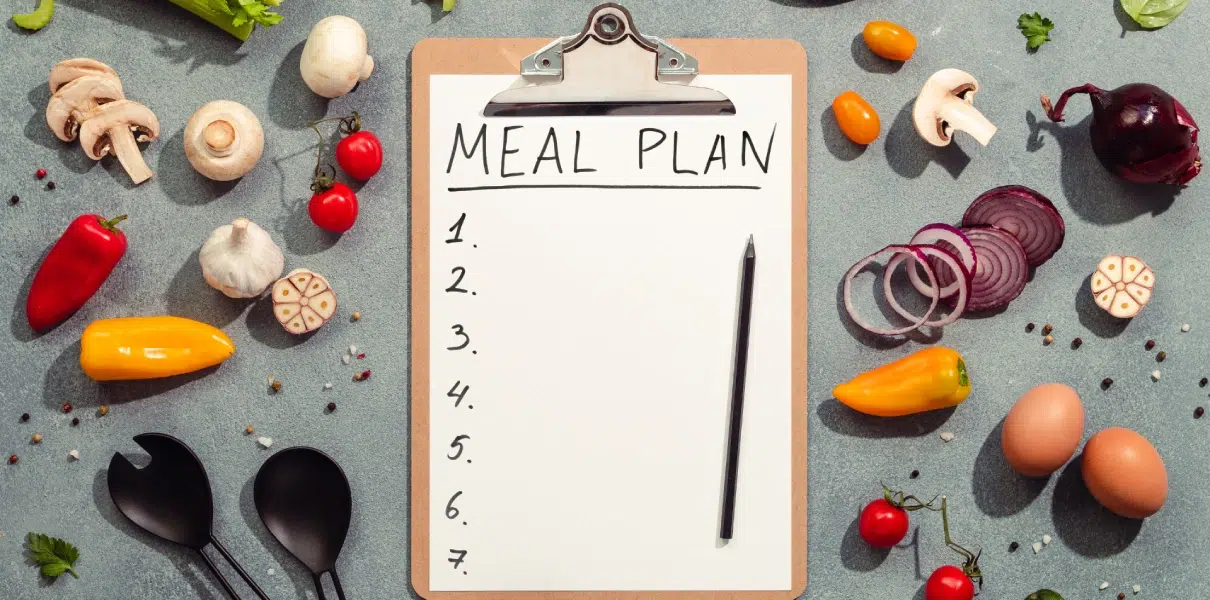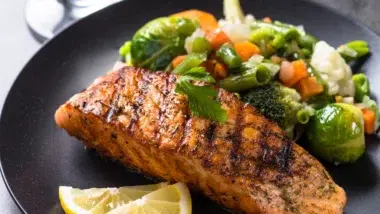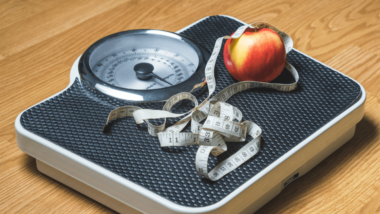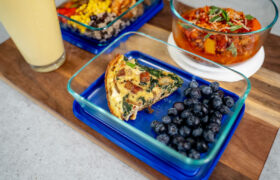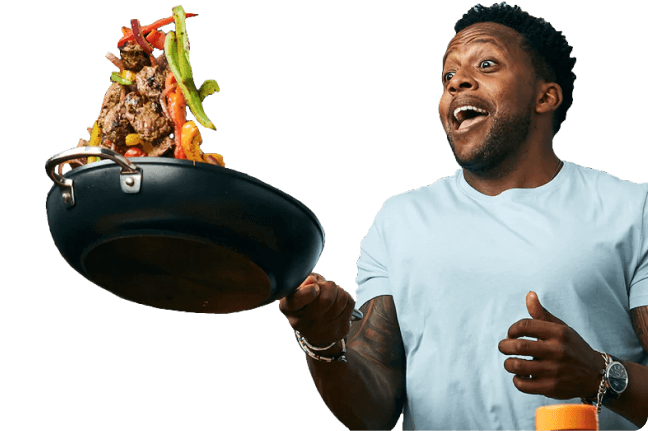Welcome to the epic journey of a 3,000-calorie bulking meal plan, my friends! We’re about to tackle this adventure with some savvy planning.
The usual 2,000-calorie gig works for many, but if you’re all about smashing fitness goals, rocking an active job or sport, or looking to add some weight, it’s time to kick things up a notch.
Enter the meal planning party – your ticket to ensuring those 3,000 calories are a powerhouse of nutrition and balance. Whether you’re looking to bulk up or fuel a high-octane lifestyle, having a game plan is your secret sauce, especially when life throws its curveballs.
No need to stress about planning; it’s easy and straightforward. All you need to do is pick balanced meals, jot down a smart shopping list, and prep your food ahead of time. This way, meal planning not only keeps you on track with your nutrition but also boosts your energy, reduces food waste, and saves you money.
Ok, ok… That may sound like a lot of work to some. But don’t worry! I’ve got your back!
This article is all about getting you started on your 3000-calorie meal plan to gain weight or maintain high-level activity. With this step-by-step guide, you’ll be good to go!
For additional resources on meal prep for bulking, check out these articles:
High-Calorie Meal Plan
Meal Prep Muscle Building
How to Meal Prep for Gaining Weight (Recipes & Tips)
Why Would Someone Want to Gain Weight?
Gaining weight isn’t just about the scale; it’s about building muscles, excelling in sports, recovering from health issues, and boosting confidence. Whether it’s for energy, health, or strength, gaining weight can be a positive journey. So, let’s embrace those reasons and make those gains!
Who Should Follow a 3,000-Calorie Diet?
If you’re on a mission to fuel your body with the good stuff, sometimes that means cranking up the calorie count. Why? Well, there’s a bunch of reasons why someone might go for a high-calorie diet, and they’re all about personal goals and lifestyles. Let me break it down for you:
- Building Those Gains: If you’re hitting the gym hard and want to pack on some muscle, you gotta give your body the extra calories it needs to grow and thrive.
- Game Day Ready: Athletes, listen up! Whether you’re running marathons or training like a beast, you need that calorie boost to keep your performance at its peak.
- Metabolic Mojo: Some folks just naturally burn through calories like nobody’s business. Blame it on a fast metabolism or whatever, but they’ve got to eat a bit extra to keep things balanced. (Most of us wish we were in this category! 😂)
- Bouncing Back: Imagine you’re recovering from a tough time – be it illness or surgery. Your body’s like, “Hey, I need more fuel to heal up and get back in the game.”
- Work Hard, Eat Harder: If your job’s got you moving and shaking all day, or if you’re just one of those active souls, those extra calories are like your secret weapon for staying energized.
- Beat the Skinny Struggle: For those who are looking to put on a few pounds or combat malnutrition, a high-calorie diet is what your body needs.
Remember, while a high-calorie diet can be right in certain situations, it’s all about balance. Don’t forget the veggies, lean proteins, and all that good stuff. And hey, if you’re not sure what’s right for you, chatting with a healthcare pro or a nutrition guru is always a smart move.
What Is a Safe Rate of Weight Gain?
Studies say it’s safe to gain about 0.5 – 2 pounds per week. Severely undernourished people may be able to gain about 4 pounds a week safely.
Here’s the deal: speed is not the goal here. Quick weight gain can bring on discomfort – we’re talking bloating and messing with an athlete’s A-game. Plus, it might play a hand in upping the risk of heart disease.
How fast you pack on those pounds depends on what your body needs in the calorie department. If you’re used to cruising at 2,000 calories and suddenly hit 3,000, you’re on the fast track to gaining weight quicker than someone who was previously hanging out at 2,500 calories.
Stick to the slow and steady approach, aiming for that 0.5 – 2 pounds per week. It’s the safe and effective route to your weight gain journey.
Why Is Nutrition Important for a 3,000-Calorie Diet?
Nutrition is the MVP here for several reasons:
- Providing Essential Energy: Think of your body as a high-performance engine. To keep it running smoothly on that 3,000-calorie highway, you need top-notch fuel. Balanced nutrients ensure you’re getting the energy, vitamins, and minerals your body craves.
- Supporting Muscle Building: If you’re on this journey for gains, nutrition is KEY. Adequate protein, carbs, and healthy fats play an essential role in muscle building and recovery.
- Boosting Sustainable Energy: More calories mean more energy, but it’s crucial to get the right kind. Complex carbs, like whole grains, and nutrient-rich foods will keep you energized throughout the day. No sugar crashes here!
- Maintaining Overall Health: It’s not just about the calories – it’s about what those calories bring to the table. A well-rounded diet helps maintain heart health, keeps your immune system in check, and supports various bodily functions. It’s the holistic approach to rocking that 3,000-calorie lifestyle.
- Avoiding Processed Junk: Hitting 3,000 calories with a bunch of processed junk? Not the move. Nutrient-dense foods make sure you’re not just hitting the calorie count but also giving your body the goodness it deserves. Processed junk means missing important nutrients. It also means eating unhealthy sugars and fats, artificial additives, too much salt, and often just eating too much. This kind of eating often leads to nutritional deficiencies, obesity, cardiovascular diseases, type 2 diabetes, and hypertension. That’s right, don’t do it! A balanced, nutritious diet is super important for your general health.
So, in a nutshell, nutrition needs to be the compass guiding your 3,000-calorie journey. It’s not just about the quantity; it’s about the quality of those calories. Feed your body right, and it’ll thank you with gains, energy, and overall awesomeness!
How Can I Eat 3,000 Calories a Day?
Let’s break down how to hit that 3,000-calorie mark without breaking a sweat:
- Larger Portions: Go for larger portions in your meals. Load up on grains, proteins, and healthy fats to amp up those calories.
- Frequent Meals and Snacks: Break your day into 5-6 snack-sized meals. It’s like a calorie boost without feeling like you’re in a food coma.
- Choose Nutrient-Dense Foods: Choose foods that pack a nutrient punch. Think lean proteins, whole grains, fruits, veggies, and good-for-you fats.
- Healthy Fats: Bring in the healthy fats, like avocados, nuts, seeds, and olive oil. They’re like the secret sauce for hitting your energy goal.
- Protein-Rich Foods: Load up on proteins – meats, fish, eggs, dairy, and plant-based goodies. They’re the building blocks for muscles.
- Snack Smart: Grab calorie-dense snacks like trail mix, nut butter on toast, or some Greek yogurt with extra goodies.
- Smoothies and Shakes: Smoothies and shakes are your new best friends. Toss in bananas, protein powder, yogurt, and nut butter for a tasty calorie boost.
- Hydration: Don’t forget the drinks! Smoothies, milk, or real fruit juices add extra calories to your tally.
- Meal Planning: Map out your meals and snacks so hitting that 3,000 is a breeze.
- Exercise Regularly: Throw in some strength training. It’s like telling your body, “Let’s grow!”
And remember, if you’ve got health goals or questions, chatting with a pro can be a game-changer. Now go crush those calories!
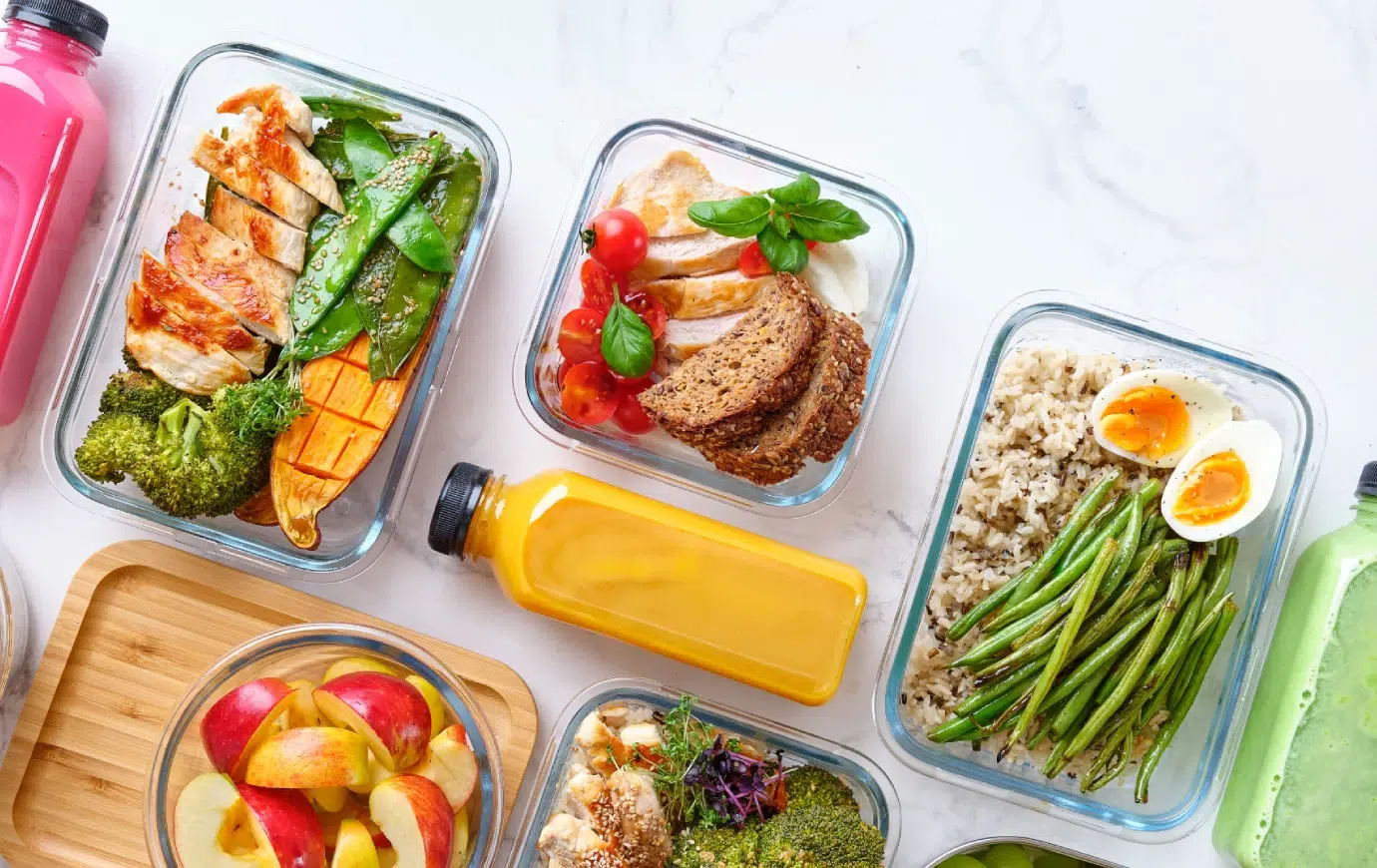
7-Day Sample 3,000 Calorie Meal Plan, High Protein
If you’re wondering, “What does 3,000 calories look like?” Here’s a sample menu of basic foods that could get you to a 3 000 calorie diet:
Day 1:
Breakfast:
- Two slices 100% whole wheat bread
- Two fried eggs
- 1/2 medium avocado
- 1 cup 2% plain Greek yogurt
- 1/4 cup diced strawberries
Snack:
- 1 apple
- 2 tablespoons peanut butter
Lunch:
- Salad with 1/2 cup chickpeas, 1/4 cup olives, 1/4 cup feta cheese, tomatoes, cucumbers, and 2 tablespoons balsamic vinaigrette dressing
- One 6-inch 100% whole wheat pita bread
- 1/4 cup hummus
Snack:
- 15 almonds
- 1 clementine
Dinner:
- 4 ounces baked chicken
- 1 1/2 cups lentil pasta
- 2 tablespoons pesto
- 12 Brussels sprouts roasted in 1 tablespoon olive oil
Snack:
- 2 cups popcorn
- 1 ounce 70% dark chocolate
Additional or Late-night Snack:
- 3/4 cup 2% Greek yogurt + 1/2 scoop whey protein
Day 2:
Breakfast:
- One 4-inch whole wheat bagel
- Two slices tomato
- 3 tablespoons cream cheese
- 3 ounces smoked salmon
- Green onions
- 1 banana
Snack:
- 15 almonds
- 4 slices dried mango
Lunch:
- Salad with 2 tomatoes, 2 tablespoons chopped Basil, ½ chopped onion, ½ cup diced Mozzarella cheese, 2 teaspoons Balsamic vinegar, 2 tablespoons Olive oil, salt and pepper
Snack:
- 1 ounce cheddar cheese
- 10 whole-grain crackers
Dinner:
- 4 ounces baked chicken
- 1 cup brown rice
- 1 red bell pepper, sliced
- 1/4 cup shelled edamame
- 2 tablespoons peanut sauce
Snack:
- 1 medium brownie
- 1/2 cup regular whole milk ice cream
Additional or Late-night Snack:
- 1 cup 2% Greek yogurt + 1 tablespoon nut butter + 1/4 cup berries
Day 3:
Breakfast:
- 1 cup oatmeal, cooked in 1 cup 2% milk
- 2 tablespoons peanut butter
- 1 small apple, chopped
- 1 teaspoon cinnamon
- 1 tablespoon chia seeds
Snack:
- 1 cup grapes
Lunch:
- Black bean and corn quesadilla with 1/2 cup black beans, 1/2 cup corn kernels, and 1/4 cup shredded cheddar cheese on an 8-inch whole wheat tortilla
- 1/4 cup salsa and 1/2 cup guacamole
Snack:
- 1 cup whole milk plain Greek yogurt
- 1/4 cup low-sugar granola
Dinner:
- 4 ounces grilled salmon
- 1 1/2 cups whole wheat pasta with 1/2 cup tomato sauce
- 1/2 cup broccoli roasted with 1 tablespoon olive oil
Snack:
- 3 medium chocolate chip cookies
Additional or Late-night Snack:
- Shake with 1.5 cups almond milk + 1 scoop whey protein + 1 cup spinach + 1/4 cup walnuts
Day 4:
Breakfast:
- Two slices 100% whole wheat bread
- 2 tablespoons peanut butter
- 1 large banana
- Two hard-boiled eggs
Snack:
- 1 small blueberry muffin
Lunch:
- Wrap with one 8-inch whole wheat tortilla, 4 ounces sliced turkey, one slice cheddar cheese, 1 tablespoon mustard, and mayonnaise
- 1 cup diced watermelon
- 1-ounce bag pretzel twists
Snack:
- 12 tortilla chips
- 1/2 cup guacamole
Dinner:
- 4 ounces grilled steak
- 1 cup mashed potatoes
- 12 asparagus spears roasted with 1 tablespoon olive oil
Snack:
- 2 cups plain popcorn
- 2 ounces 70% dark chocolate
Additional or Late-night Snack:
- 3/4 cup 2% Greek yogurt + 1/2 scoop whey protein
Day 5:
Breakfast:
- 2 slices of 100% whole wheat bread
- 1/2 medium avocado
- 2 fried eggs
- 1 cup 2% plain Greek yogurt
- 1 cup cubed honeydew
Snack:
- 1 large banana
- 2 tablespoons peanut butter
Lunch:
- 1 can tuna with 2 tablespoons mayonnaise
- 8-inch whole wheat wrap
- 1-ounce bag potato chips
- 1 medium tangerine
Snack:
- 1 small blueberry muffin
Dinner:
- 4 ounces grilled chicken with 2 tablespoons barbecue sauce
- 1 cup cooked quinoa
- 1 cup broccoli roasted in 1 tablespoon olive oil, salt, and pepper
Snack:
- 1 large peach
- 12 walnuts
Additional or Late-night Snack:
- 3/4 cup 2% Greek yogurt + 1/2 scoop whey protein
Day 6:
Breakfast:
- 1 cup whole milk plain Greek yogurt
- 1/2 cup low-sugar granola
- 1/2 cup raspberries
- 2 teaspoons honey
Snack:
- One slice 100% whole wheat bread
- 2 tablespoons peanut butter
Lunch:
- One 5-ounce can tuna mixed with 2 tablespoons mayonnaise
- One 8-inch whole wheat wrap
- One 1-ounce bag potato chips
- 1 medium tangerine
Snack:
- 3 tablespoons tzatziki dip
- 1/2 cup baby carrots
- 1-ounce bag pita chips
Dinner:
- 4 ounces tofu
- 1 1/2 cups rice noodles
- 1/2 cup snow peas
- 1/2 cup shelled edamame
- 2 tablespoons peanut sauce
Snack:
- Three Medjool dates
- 2 tablespoons almond butter
- 1 ounce 70% dark chocolate
Additional or Late-night Snack:
- 1 cup 2% Greek yogurt + 1 tablespoon nut butter + 1/4 cup berries
Day 7:
Breakfast:
- 1 cup whole milk plain Greek yogurt
- 1/2 cup low-sugar granola
- 1/2 cup blueberries
- 2 teaspoons honey
Snack:
- 15 cherries
- 20 almonds
Lunch:
- 1 1/2 cups lentil soup
- 2 slices 100% whole wheat bread with two slices cheddar cheese and two slices tomato
Snack:
- 1 1-ounce bag pita chips
- 1/2 cup baby carrots
- 1/2 cup hummus
Dinner:
- 4-ounce turkey burger on a 100% whole wheat bun with lettuce, tomato, and 1 tablespoon ketchup
- 1 zucchini sliced into spears, roasted with 1 tablespoon olive oil
- 1/2 regular potato, sliced into French fries and baked with 1 tablespoon olive oil, salt, and pepper
Snack:
- 1 cup regular whole milk ice cream
- 1/4 cup chocolate chips
Additional or Late-night Snack:
- 3/4 cup 2% Greek yogurt + 1/2 scoop whey protein
This simple 3,000 calorie meal plan should give you some ideas, but be sure to double-check the actual calorie counts on food labels. And for more inspiration on planning your meals, check out the delicious recipes I’ve been sharing over at Fit Men Cook.
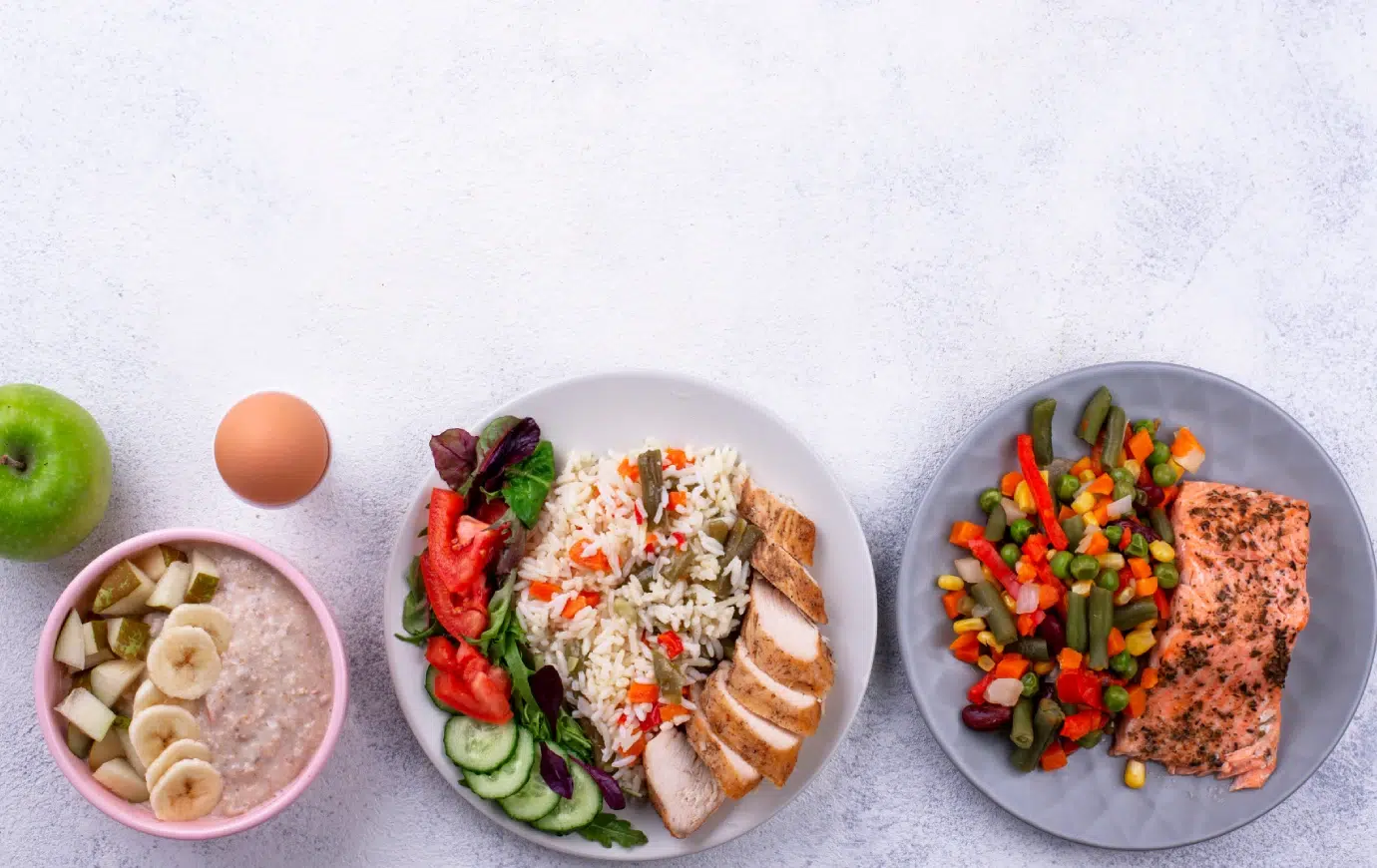
Frequently Asked Questions: 3,000-Calorie Meal Plan
1. Why would someone follow a 3,000-calorie diet?
People eat a 3,000-calorie diet for different reasons, like bulking up, supporting intense workout routines, or maintaining weight for physically demanding jobs.
2. What if I eat 3,000 calories a day for a month?
If you consistently eat more calories than you use each day, you’ll likely gain weight. It’s important to monitor your body’s response and change your diet based on your health and fitness goals.
3. Is a 3,000-calorie diet suitable for weight loss?
Typically, a 3,000-calorie diet isn’t for weight loss. Most people targeting a diet like this would have goals like muscle gain, intentionally gaining weight for health purposes, or maintaining weight with an active lifestyle.
4. What foods should I include in a 3,000-calorie diet?
A high-calorie diet doesn’t mean going to town on junk foods. Focus on nutrient-dense foods like lean proteins, whole grains, fruits, vegetables, and healthy fats. Balancing macronutrients is key to meeting your nutritional needs.
5. Can I indulge in junk food on a 3,000-calorie diet?
While the occasional treat is definitely okay, it’s important to prioritize nutrient-rich foods. Avoid those empty calories and shoot for a well-rounded, balanced diet.
6. Do I need to follow a strict meal plan on a 3,000-calorie diet?
A meal plan can be helpful – especially if 3k calories a day isn’t your norm – but your meal plan doesn’t have to be rigid. Flexibility is key, but starting out with a basic meal plan structure can help you meet your calorie and nutritional goals.
7. What can I eat to get 3,000 calories a day?
Opt for a mix of lean proteins, whole grains, healthy fats, fruits, and vegetables. Include foods like chicken, fish, quinoa, avocados, nuts, and seeds to meet your calorie goal.
8. How does meal planning fit into a 3,000-calorie diet?
Meal planning is one of many tools to help you stay on track nutritionally while meeting your calorie goals. Meal prepping can help with portion control, balanced meals, and strategic food choices.
9. Is a 3,000-calorie diet suitable for everyone?
No, people are different and so are their goals. When meal planning, you should consider factors like activity level, body size, and specific goals. Talk with a nutritionist or healthcare professional for extra help knowing how to reach your goals with your body type and lifestyle.
10. Can a 3,000-calorie diet be sustainable in the long term?
That depends on your preferences and lifestyle. It definitely can be done under the right circumstances. Diet and exercise are always about finding the balance that works for you. It’s important to choose the foods and exercise that bring you happiness.
11. Are there risks associated with a 3,000-calorie diet?
Consuming too many calories, especially from unhealthy sources, can lead to weight gain and health issues. If you’re loading up the calories, you MUST prioritize healthy food choices and pick nutrient-dense foods that support overall well-being.
12. Can a 3,000-calorie diet be adapted for vegetarian or vegan lifestyles?
Absolutely! Plant-based sources of protein, whole grains, nuts, seeds, and fruits can be incorporated to meet the calorie and nutritional needs of a 3,000-calorie diet for those following vegetarian or vegan lifestyles.
13. How much weight will I gain if I eat 3,000 calories a day?
Weight gain depends on a lot of factors, including your metabolism and activity level. Consistently eating 3,000 calories a day is likely to lead to more and more weight gain unless you live a highly active lifestyle.
14. Is it possible to eat 3,000 calories in one meal?
And not get sick? Good luck! It definitely wouldn’t be recommended for most people. Try to spread your calorie intake throughout the day. This is nicer on your body and will give you sustained energy.
For more tips and recipes check out Fit Men Cook.
